Treehouses are emblematic of the hurly-burly of pre-adolescence—throwbacks to an antic time of romping around in the yard, playing tag, climbing trees, building treehouses. They touch upon the bit of youthful whimsy that resides in everyone of every age.
B’fer (pronounced BEE-fer) Roth, co-owner of the Treehouse Guys in Warren, Vt., gets it. The treehouses he and partner Chris Haake design and assemble eschew the rigid conformity of right angles and the familiar look of ground-based structures. “We’re getting away from the normalcy of a house on a static foundation,” he says. “A treehouse is the essence of a childlike recollection, tapping into that inner-child thing.”
In short, the appeal of treehouses as a way to play in the trees is timeless and ageless. Why, then, have relatively few adventure parks across the country incorporated treehouses into their above-ground tours as rest stations or gathering spots, or as lodging or dining options? The fun-in-the-trees fit between treehouses and aerial adventure tours seems a natural. Yet adventure-tour treehouses are still relatively few and far between.
Those that do have treehouses, though, are thrilled with them.
A Stop on the Tour
Of the many treehouses the Treehouse Guys have built, Roth could think of only one, at Timberline Adventures in Coeur d’Alene, Idaho, built at an adventure park. Timberline finds multiple ways to put its treehouse to use: as a mid-tour rest stop, as a spot to enjoy box lunches, and even as a stopover for an evening s’mores tour. The combination of a treehouse and roasted s’mores—a fuller recapturing of the spirit of youth can hardly be imagined.

Other aerial adventure operations have seen the light, too. Matt Wood, chief operating officer at Alpine Adventures, says the New Hampshire aerial adventure operator constructed a treehouse because “we wanted something that would set us apart from the rest.” A treehouse, able to hold about 14 people at one time, and with a wrap-around deck and expansive views of the White Mountains, was a way of accomplishing that goal. It certainly provides a unique, add-on attraction. “It’s not every day that you get to spend time in a treehouse,” Wood says.
Fundamentally, a treehouse is a shelter. That fact was also critical in Alpine Adventures’ decision to build its treehouse. At a year-round operation in a part of the country known for fierce winter weather, being able to sip hot chocolate in front of a small fireplace in a fully enclosed shelter has been welcome relief from the winter cold for zip-liners. In warmer weather, with air circulating through open French doors and windows and with the opportunity to relax on the deck and enjoy the views, the treehouse serves as an attractive summer rest stop between zip line segments.
Elevated Lodging
In building two treehouses at Historic Banning Mills in Georgia, co-founders Mike and Donna Holder went a step further. Rather than simply being a mid-tour rest stop, the Historic Banning Mills treehouses are overnight lodging alternatives to the resort’s main 52-room inn. The treehouses became, says Donna, “an immediate hit,” both for guests and for the company’s bottom line. The initial investment was recouped quickly, with an ROI of just two years.
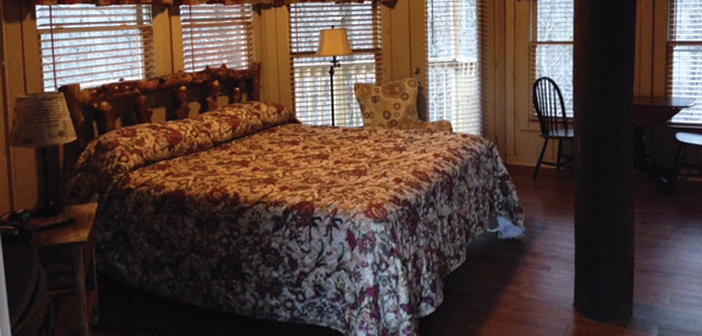
On the heels of that initial success, the Holders are planning to add a few more treehouses to the lodging mix. But Donna is so enthusiastic about the concept that she says, “We’d have a hundred if we could.”
Cypress Valley in Austin, Texas, also devotes its five treehouses to lodging, and co-owner Will Beilharz has one explanation for why treehouses, at least for overnight accommodations, might not be a fit for all adventure parks. “People want something more peaceful and romantic,” says Beilharz, and the activity of a canopy tour may disrupt that. In other words, treehouse dwellers and tour guests represent “different user types,” he says. That might be especially true when targeting a fairly high-end lodging market, as Cypress Valley does, with nightly rates ranging from $250 to $650.
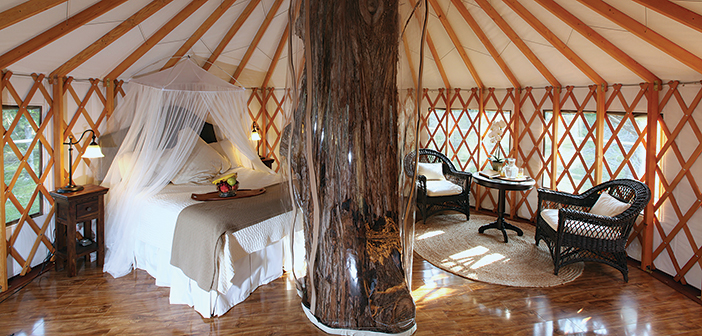
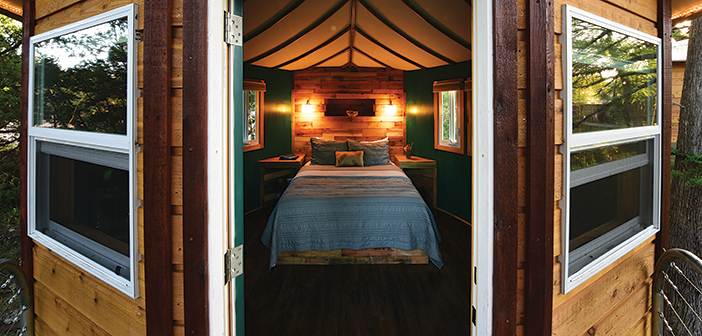
Construction and Logistics
Of course, building any structure as much as 65 feet above the ground, as is the case with the treehouses at Historic Banning Mills, comes with inherent logistical challenges. Key among those challenges is providing a flat and stable foundation on a platform of tree trunks and limbs that inherently lack stability and conformity. More specifically, trees move, especially in gusty winds, and any treehouse siting and anchoring method has to take that movement into consideration.
The treehouses at Historic Banning Mills address the challenge by avoiding the trees altogether. Elevated above the ground and into the forest canopy on utility poles, the resort’s treehouses might technically not live up to their name, but clearly resort guests are finding no reason to quibble. They get an opportunity to spend a night in a rare, natural setting, so who cares what’s underneath the treehouse floor? But even on utility poles, the treehouses are subject to movement in the wind, even if grounded guy wires provide stability.
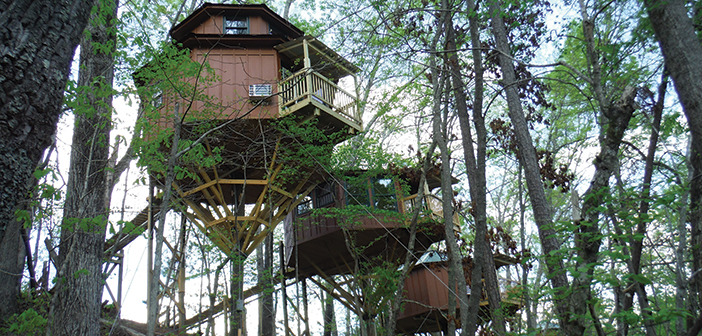
At Alpine Adventures, the treehouse is anchored to the trees with thru-bolts. The Treehouse Guys use Garnier Limbs, a treehouse bolt-and-bracket device developed over the past two decades in the Pacific Northwest. The “limbs” allow, as Roth puts it, “the whole platform to hover and glide.” The Treehouse Guys work with two engineers specializing in treehouses to determine the feasibility of installing a treehouse at any particular site, and also consult with an arborist to assure that any installation won’t interfere with the continued health and growth of impacted trees.
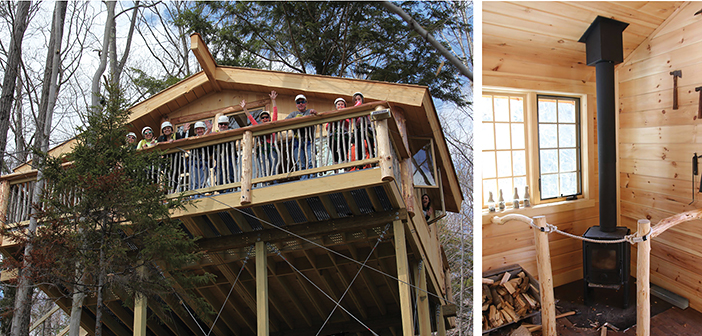
Another logistical challenge can be access. Adults might like the idea of recapturing their childhood by being in a treehouse, but few are apt to enjoy the idea of scrambling up a tree to get to one. At Historic Banning Mills, the treehouses are positioned on a slope, where access from a ridgeline at close to the same elevation as the treehouses is via fairly level ramps.
According to Roth, sometimes the design and construction of an access ramp, especially at shallow inclines if intended to meet ADA standards, can be more of a challenge than the design of a treehouse itself. Of course, at a rest stop on a canopy tour where guests are already at height, there would be no need for ramp building.
Choose Your Style
Once a site has been chosen and the anchoring system and means of access determined, almost anything goes. “It’s phenomenal how much weight you can put onto several trees,” says Roth, implying that almost any structure you might build on the ground could be translated into a treehouse. That said, the Treehouse Guys like the idea of treehouses that are slightly eccentric, sometimes even allowing parts of a tree to pass right through the heart of the structure, in order to differentiate them from ground-based structures.
The Alpine Adventures treehouse is in the style of a mountain-chalet cabin that could easily look at home on the ground. But there is also a nod to whimsy here, too, with balustrades beneath the deck railing made of rustic branches. The Historic Banning Mills treehouses also tend toward a more traditional, ground-based design.
Solid Investment
It only takes a relatively modest investment to get into the treehouse game. Roth sets a price range for the Treehouse Guys starting at about $25,000 for a fairly simple structure (“a gazebo in the air,” as Roth puts it) to as much as $200,000 for a fully insulated, fully livable structure.
The building costs for the nicely appointed treehouses at Cypress Valley ranged from $75,000 to $200,000. Factor in the quick return on investment, as reported by the Holders at Historic Banning Mills, and it would seem that money, when it comes to building treehouses, is not really an object.
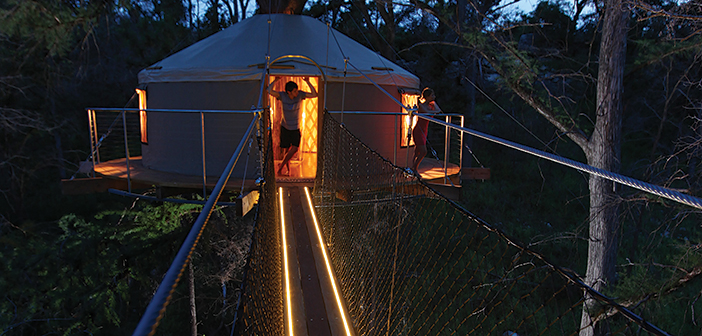
Given the obvious crossover between elevated adventure tours and treehouses, it would seem that the installation of more adventure-park treehouses is on the near horizon. “A check-in center or a welcome center—there are a lot of different ways a treehouse can be used,” says Beilharz, who also owns his own treehouse design-build company, Artistree, although he suggests a treehouse can make more sense if it is a revenue generator—lodging, food,
or whatever.
If such an icon of eternal youth can be had for little more than a budgetary tweak, installing a treehouse—or two, or more—seems close to a no-brainer.





